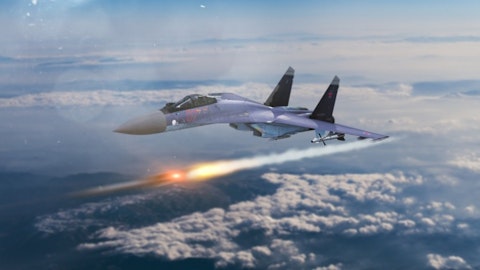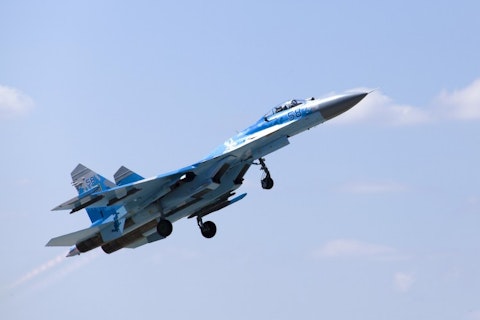These 8 fastest, most advanced Russian fighter jets are sure to give pause to anyone thinking of challenging Russia.
The air power has always been one of the staples of Soviet (and Russian) military might. During the Cold War, together with tanks and nuclear submarines, the West most mostly concerned about various MiGs and Sukhois stationed on airfields all over Mother Russia. Although there aren’t any Russian airplanes among the Fastest Commercial Passenger Planes in the World Today, when it comes to military aviation, Russia still has the know-how to make fearsome fighting machines.
Modern Russian Air force (or VVS, as it is abbreviated in Russian) often seems like a poor cousin, compared to the Red Air force that stroke fear into the hearts of NATO planners. During the 1990s and the collapse of the Soviet Empire, there was never enough money for training flights, fuel, basic maintenance or even pilots’ salaries. Naturally, this led to a drastic fall in performance and readiness, seriously cutting into the number of available fighters and personnel.

With the rise of Vladimir Putin and, more importantly, sky-high oil prices in the early 2000s, things started to improve. New designs were created and the government started procuring new airplanes once again. Although the technological gap with the Western air forces, which was always present but grew significantly wider in the 1990s, seemed insurmountable, Russian designers managed to keep their fighters competitive, despite a lack of research on the scale of the United State Air Force.
Today, the Russian Air Force is a far cry from the joke it was in the 1990s. Although not quite back to Soviet levels, it represents a potent threat to any Russian enemy and in some cases can even be considered on par with the 11 Fastest US Air Force Fighter Planes. With significant funds being poured into joint research with China and India, things are bound to improve even more, and soon we will need a new list of 10 fastest, most advanced Russian fighter jets.
However, Russian intervention in Syria revealed some glaring shortcomings in both procedures and pilot training, which, many would argue, are far more important than the airplane itself when it comes to combat.
In order to create the list of 8 fastest, most advanced Russian fighter jets we started from the Global Security’s page listing Russian aircraft. Then we narrowed the list down by eliminating airplanes no longer in active service. This left us with 8 models we ranked according to speed and year they entered service. We also added points for the technological generation of the aircraft (4, 4+, 4++ and 5).
8. Su-25SM3
Speed: Mach 0.82
In service: 2014
Although strictly speaking Su-25 is an attack jet, it does possess the ability to carry both K-13 and R-60 air-to-air missiles, which give it some multirole ability and can be stretched into a fighter category.
After Afghanistan debacle, Soviet Air Force decided that Su-25, already in service since the 1970s, needed an upgrade in order to increase its capabilities and survivability. The new design was named Su-39, but ultimately it was too pricey to procure in numbers Russians needed. The Less ambitious project was called for and Su-25SM was born. It features new electronics, including laser targeting system, and new avionics suite.
After deficiencies were observed in the Russo-Georgian war in 2008, extensive testing was performed and new laser optical system was installed, together with Vitebsk protection suit on several jets deployed in Syria. After they proved its increased effectiveness, the new model was dubbed Su-25SM3 tht ranks 8th on our list of fastest, most advanced Russian fighter jets, although it remains unclear whether Russians plan to upgrade their entire fleet of Su-25 to this new standard.
7. Sukhoi Su-27SM
In service: 2004
Speed: Mach 2.35
Arguably the most successful Soviet fighter design, Sukhoi Su-27 spun the design of several other highly successful fighters present on our list of fastest, most modern Russian fighter jets. Originally, Soviet Airforce wanted a fighter able to compete with the new F-15 Americans were designing in the late 1960 and early 1970s. It turned out that specifications were too costly for a single airframe, so the program was split into Light and Heavy fighter. Light fighter resulted in MiG-19 and Heavy in Su-27. The Chinese reverse-engineered some of the Su-27 bought from Russia in the 1990s into Shenyang J-10. The SM version (serial moderniziroval – serial modernized) incorporates many technologies demonstrated on advanced Su-30 and Su-35 models. Now, let’s see what else do we have on our list of fastest, most advanced Russian fighter jets.

6. Sukhoi Su-30SM
In service: 2009
Speed: Mach 2.0
Su-30 was conceived as a long-range interceptor, able to cover vast expanses of Russia without the need for many refueling. The design evolved over time and the end product is a 4+ generation multirole jet fighter. The main visual differences between Su-27 and Su-30 are added canards and a two-seat cockpit in Su-30. With thrust vectoring, Su-30is one of the most maneuverable fighters in service today. The fighter has been a huge export success, in part to customization packages offered by Sukhoi, so that each customer could tailor it to their needs. Each variant has its own designation, MKI for India, MKK for China, MKM for Malesia, MKV for Venezuela and few others. A majority of Su-30s in Russian service are of SM version.
5. Sukhoi Su-34
In service: 2014
Speed: Mach 1.8+
We are continuing our list of fastest, most advanced Russian fighter jets with Sukhoi Su-34 that is another project from the Soviet era that saw fruition in Putin’s Russia, benefiting from the high oil prices in the early 2000s. The fighter-bomber is praised as one of the most successful designs in Sukhoi history. Based on Su-27, the jet has a distinctive duck beak-like nose cone, for housing various radar and targeting equipment. Unlike other fighters, its cabin has enough space for the two pilots to get out of their seats, stretch their legs end even lie down. This was deemed important by the designers since one of the plane’s missions is long range strikes against enemy targets. Su-34 saw action for the first time in Syria, with huge success.
4. Sukhoi Su-35
In service: 2014
Speed: Mach 2.25
Intended as a fighter that will bridge the gap between classic 4th generation fighters like Su-27 and Su-30 and the 5th generation aircraft like T-50, Su-35 that ranks 4th on the list of fastest, most advanced Russian fighter jets is usually labeled as the 4++ generation fighter. Even though it bears many similarities with its venerable predecessor Su-27, there are enough differences that it deserves its own entry. The first fighter jet bearing the Su-35 designation was designed in the 1980s. Due to the collapse of the Soviet Union, the project was abandoned. In 2003, a new Su-35 entered the design phase. It entered service with the Russian Air Force in 2014.
3. Mikoyan MiG-31 BM
In service: 2014
Speed: Mach 2.83
The West first learned of new Soviet interceptor dubbed MiG-31 from a defector pilot Lieutenant Viktor Belenko in 1976. Belenko took his Mig-25 to Japan and asked for a political asylum. In return, he told everything he knew (and some things he didn’t know, as it turned out later) about Soviet air force to the Western intelligence services. Among other things, he informed them that Kremlin is working on a new high-speed interceptor, based on MiG-25.
MiG-31 was the first fighter in the world (and the only one, until 2000) to be equipped with a phased array radar. It allowed it look down/shoot down ability, crucial for the interception of low flying high-speed targets below the horizon, like Tomahawk cruise missiles.
In 2014, MiG-31 BM that ranks 3rd on our list of fastest, most advanced Russian fighter jets was introduced into service, with several major upgrades over the original model. The radar was improved, allowing it to track 10 and attack 4 targets simultaneously at the range of 200 km and a brand-new avionics suit was incorporated, which vastly improve airplane handling.
2. Mikoyan MiG-35
Speed: Mach 2.25
In service: 2018
Originally, MiG-29, the next one on the list of fastest, most advanced Russian fighter jets was designed as a light fighter, created to complement Su-27 in the protection of the Soviet air space. More than 1,600 of popular fighters were produced and exported all over the world. However, time quickly caught up with it and it was deemed obsolete. The new version, dubbed MiG-35, aims at updating the aging jet to the standards of the 21st century. Although based on MiG-19, the new design doesn’t have much in common with it, except the recognizable looks. All new avionics, AESA radar and new targeting and guidance systems have made MiG-35 capable of going toe-to-toe with almost every other jet in service today. The Russian Air Force Commander Viktor Bondarev says that the plan is to replace all of 200 MiG-29 in various versions with MiG-35 starting in 2008.
1. Sukhoi T-50
Speed: Mach 2
In service: 2018
And , finally the first place on the list of fastest, most advanced Russian fighter jets goes to the Sukhoi T-50 that is the child of the Russian PAK-Fa program, aimed at providing VVS with the fifth generations stealth jet fighter. Original program that led to the PAK FA started in the late 1980s, with a goal of creating a multifunctional jet fighter that would eventually replace both MiG-29 and Sukhoi Su-27 fleets. It gave birth to such prototypes like MiG 1.44 and Su-37 (later Su-47). The breakup of the Soviet Union effectively put a stop to that program and both fighters were canceled, but valuable lessons were learned from it, especially from Su-47, which still serves as a technology demonstrator for the Sukhoi design bureau.
With current powerplants (Saturn AL-41F1 turbofans from Su-27, but there are indications that Russians are designing brand new engines for T-50), T-50 is capable of reaching speeds of Mach 2, making it the fastest, most modern Russian fighter jet. Although there are several of them currently in service, they are mainly used for testing purposes and not for the regular duties. The procurement has been delayed several times, but is expected to start in 2018.
T-50 also serves as a foundation for the joint research between Russian and Indian Air Forces for the Indian fifth generation fighter. As the only 5th generation fighter outside of US Air Force, it desrves the top spot among fastest, most modern Russian fighter jets.





